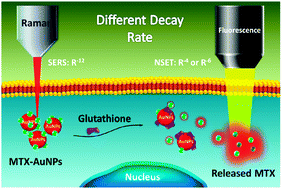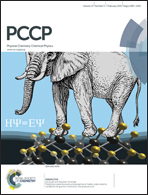Nonidentical intracellular drug release rates in Raman and fluorescence spectroscopic determination†
Abstract
Intracellular drug release rates were measured by monitoring mitoxantrone (MTX) on gold nanoparticle (AuNP) carriers by means of real-time label-free bimodal imaging with confocal Raman and fluorescence spectroscopy. The quenching nature of the MTX–AuNPs by nanometal surface energy transfer (NSET) was analyzed using the determined Stern–Volmer constant of KSV = 2.28 × 109 M−1. The amount of MTX released was estimated by both the decrease in the surface-enhanced resonance Raman scattering (SERRS) signal and the increase in the fluorescence intensity. Both SERRS and NSET provide quantitative relationships between the spectral intensities of MTX concentrations in solution. Inside live cells, the signal decay profiles of the drug release from AuNPs appeared to be faster at the beginning of the bond-breaking drug release for the SERRS (R−12) than the recovery time of the NSET (R−4 or R−6). In the first 45 min, a rather fast decay rate k of 0.0252 min−1 with a short half-life t1/2 of 27.5 min was observed, whereas the rate became significantly slower in a diffusion process, 0.0093 min−1 with a longer half-life of 101.4 min, after 45 min.


 Please wait while we load your content...
Please wait while we load your content...